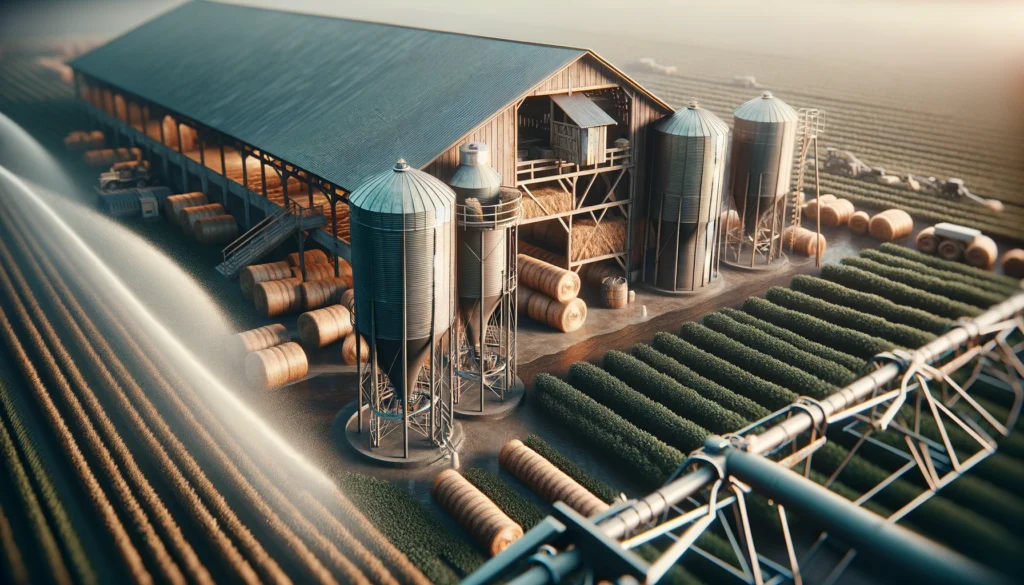
farm infrastructure agricultural buildings irrigation systems farm machinery sustainable farming resource management agricultural productivity farm maintenance renewable energy farm financing 2.webp.webp
Definition: Farm Infrastructure
Farm infrastructure refers to the physical facilities and systems necessary for the effective functioning of agricultural operations. This includes buildings, machinery, irrigation systems, roads, storage facilities, and other structures that support farming activities. Effective farm infrastructure enhances productivity, ensures the efficient use of resources, and supports the sustainability of agricultural practices. Key components of farm infrastructure include barns, silos, greenhouses, fencing, water supply systems, and power supply systems.
Investing in quality farm infrastructure is essential for modern farming operations, as it directly impacts the ability to produce, process, and store agricultural products efficiently. Well-planned infrastructure not only improves operational efficiency but also enhances the safety and well-being of farm workers and livestock.
Fall off the barn roof and busted your keister? Life on the farm or ranch can be tough on the bum. Need a break? Laugh it off at FarmerCowboy.com, the #1 farm humor site. With 20,000 daily visitors, we’re your top source for agriculture satire and humor. Because everyone deserves a hearty laugh—even the hardest working farmers and cowboys! Join us and turn those long days into fun tales at FarmerCowboy.com.
Farm Infrastructure: An In-Depth Guide
Introduction
Farm infrastructure is the backbone of agricultural operations, providing the essential facilities and systems that enable efficient production, processing, and distribution of agricultural products. This guide explores the various components of farm infrastructure, their importance, and best practices for planning, developing, and maintaining these critical assets.
Components of Farm Infrastructure
Farm infrastructure encompasses a wide range of facilities and systems, including:
1. Buildings and Structures
- Barns and Sheds: Used for housing livestock, storing equipment, and sheltering crops.
- Greenhouses: Provide controlled environments for growing plants.
- Silos and Grain Bins: Store harvested grains and other crops, protecting them from pests and weather.
2. Machinery and Equipment
- Tractors and Harvesters: Essential for planting, cultivating, and harvesting crops.
- Irrigation Systems: Include sprinklers, drip lines, and pumps to ensure adequate water supply to crops.
- Farm Tools: Various tools and implements required for daily farming activities.
3. Water Supply and Management
- Irrigation Systems: Critical for providing water to crops, especially in areas with limited rainfall.
- Drainage Systems: Help manage excess water and prevent soil erosion.
- Wells and Water Tanks: Ensure a reliable supply of water for livestock and irrigation.
4. Storage and Processing Facilities
- Storage Buildings: Used for storing harvested crops, seeds, and fertilizers.
- Processing Facilities: Include mills, dairies, and packaging plants for processing and packaging agricultural products.
5. Transportation and Access
- Farm Roads and Paths: Provide access to different parts of the farm and facilitate the movement of machinery and goods.
- Loading Docks: Used for loading and unloading produce and supplies.
Importance of Farm Infrastructure
Investing in robust farm infrastructure is vital for several reasons:
- Enhanced Productivity: Quality infrastructure improves the efficiency of farming operations, leading to higher productivity and better yields.
- Resource Efficiency: Proper infrastructure ensures the efficient use of water, energy, and other resources, reducing waste and lowering costs.
- Safety and Welfare: Well-designed infrastructure enhances the safety and welfare of farm workers and livestock, reducing the risk of accidents and improving living conditions.
- Sustainability: Sustainable infrastructure practices, such as efficient irrigation and renewable energy systems, support long-term agricultural sustainability and environmental conservation.
- Market Access: Good transportation infrastructure facilitates the timely delivery of products to markets, improving profitability and market reach.
Challenges in Developing Farm Infrastructure
Despite its importance, developing and maintaining farm infrastructure can present several challenges:
- High Initial Costs: The upfront investment required for building and upgrading infrastructure can be substantial, posing a barrier for small and medium-sized farms.
- Maintenance Requirements: Regular maintenance is essential to ensure the longevity and functionality of infrastructure, requiring time, effort, and financial resources.
- Technological Advancements: Keeping up with rapidly evolving agricultural technologies can be challenging, necessitating ongoing education and investment.
- Environmental Impact: Developing infrastructure must be balanced with environmental considerations to prevent degradation of natural resources.
- Access to Financing: Securing financing for infrastructure projects can be difficult, particularly for smaller farms with limited access to credit.
Best Practices for Farm Infrastructure Development
To effectively plan, develop, and maintain farm infrastructure, consider the following best practices:
1. Comprehensive Planning
Develop a detailed infrastructure plan that considers current needs and future growth. This plan should include an assessment of existing facilities, identification of gaps, and prioritization of projects based on their impact and feasibility.
2. Sustainable Practices
Incorporate sustainable practices into infrastructure development, such as using renewable energy sources, implementing water-saving technologies, and adopting soil conservation measures.
3. Regular Maintenance
Establish a regular maintenance schedule for all infrastructure components to prevent breakdowns and extend their lifespan. This includes routine inspections, repairs, and upgrades as needed.
4. Access to Financing
Explore various financing options, such as government grants, agricultural loans, and private investments, to fund infrastructure projects. Collaborate with financial institutions and agricultural organizations to secure necessary funding.
5. Training and Education
Invest in training and education for farm workers and managers to ensure they are knowledgeable about the latest technologies and best practices for infrastructure management.
Case Study: Successful Farm Infrastructure Development
The California Dairy Farm Initiative
The California Dairy Farm Initiative aimed to improve the infrastructure of dairy farms across the state to enhance productivity, sustainability, and animal welfare. Key elements of this initiative included:
- Energy-Efficient Buildings: Upgrading barns and milking parlors with energy-efficient lighting, ventilation, and cooling systems to reduce energy consumption and improve animal comfort.
- Advanced Irrigation Systems: Implementing modern irrigation systems to ensure efficient water use and reduce waste.
- Renewable Energy Sources: Installing solar panels and biogas digesters to generate renewable energy and reduce reliance on fossil fuels.
- Comprehensive Training Programs: Providing training for farmers on sustainable practices, equipment maintenance, and infrastructure management.
Results
The initiative resulted in significant improvements in dairy farm operations, including increased milk production, reduced energy and water consumption, and enhanced animal welfare. The use of renewable energy sources also contributed to a reduction in greenhouse gas emissions, supporting the state’s environmental goals.
Conclusion
Farm infrastructure is a critical component of agricultural operations, directly impacting productivity, efficiency, and sustainability. By investing in quality infrastructure and adopting best practices for development and maintenance, farmers can enhance their operations, support sustainable practices, and improve their overall profitability. Continuous education, planning, and access to financing are essential for the successful development and management of farm infrastructure.
How Knowledge of Farm Infrastructure Can Help Farmers
Understanding farm infrastructure helps farmers make informed decisions about investments, maintenance, and upgrades that can improve their operations. Knowledge of infrastructure components and best practices enables farmers to optimize resource use, enhance productivity, and ensure the safety and welfare of their workers and livestock. This understanding also supports sustainable farming practices and long-term agricultural success.
Resources for Further Reading
To further explore farm infrastructure and related agricultural topics, visit the following resources:

Originally posted 2024-05-24 06:29:02.
Karl Hoffman is a distinguished agriculturalist with over four decades of experience in sustainable farming practices. He holds a Ph.D. in Agronomy from Cornell University and has made significant contributions as a professor at Iowa State University. Hoffman’s groundbreaking research on integrated pest management and soil health has revolutionized modern agriculture. As a respected farm journalist, his column “Field Notes with Karl Hoffman” and his blog “The Modern Farmer” provide insightful, practical advice to a global audience. Hoffman’s work with the USDA and the United Nations FAO has enhanced food security worldwide. His awards include the USDA’s Distinguished Service Award and the World Food Prize, reflecting his profound impact on agriculture and sustainability.


